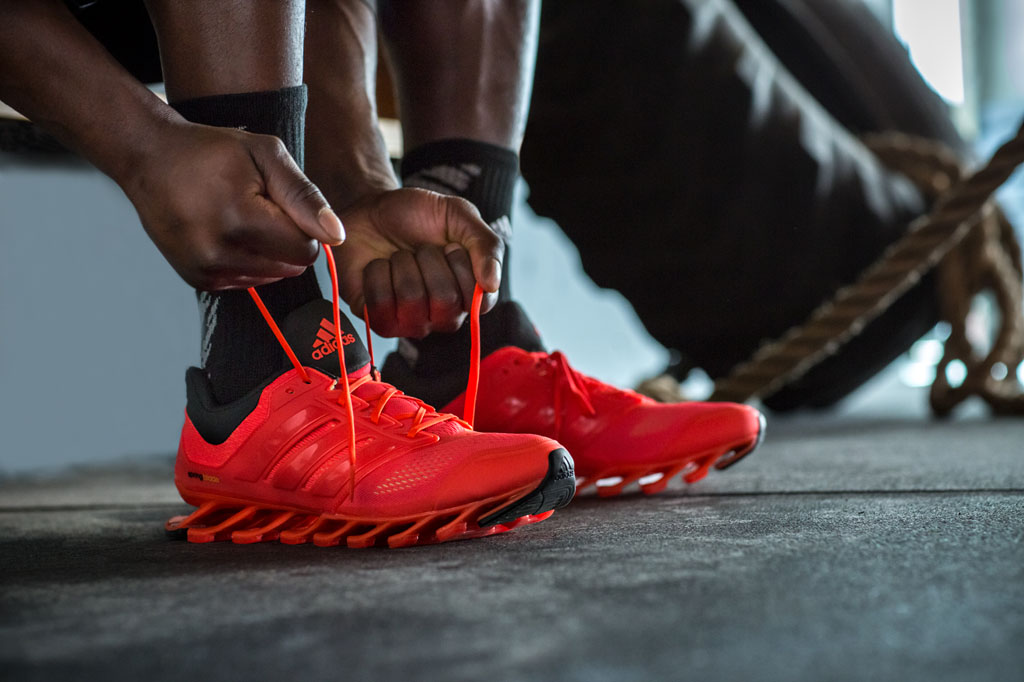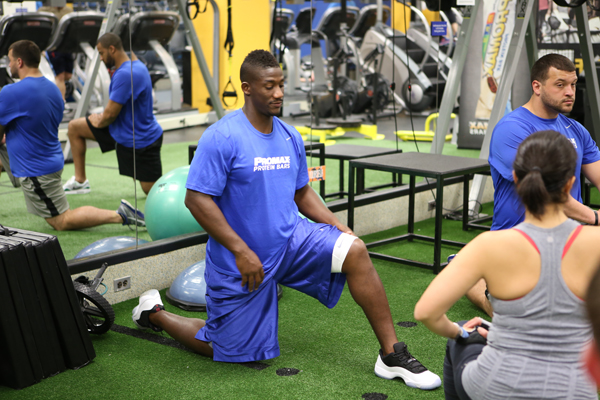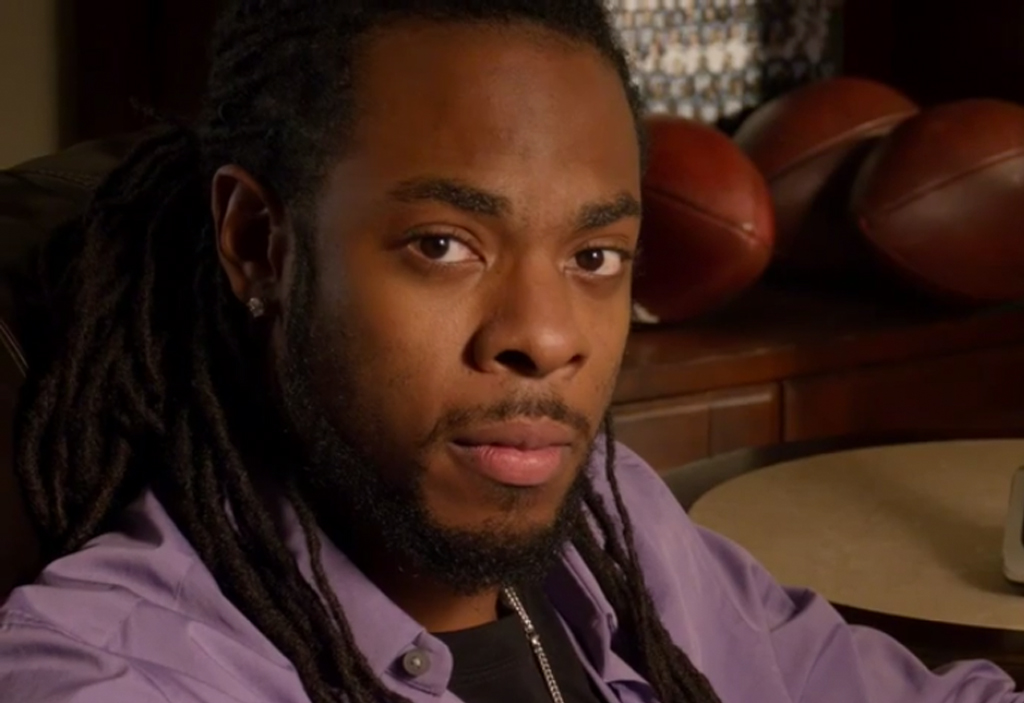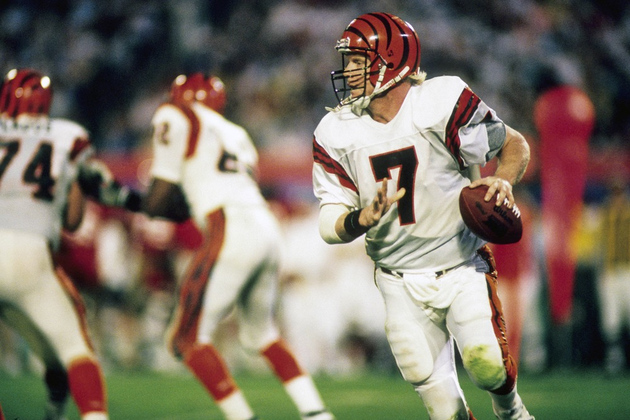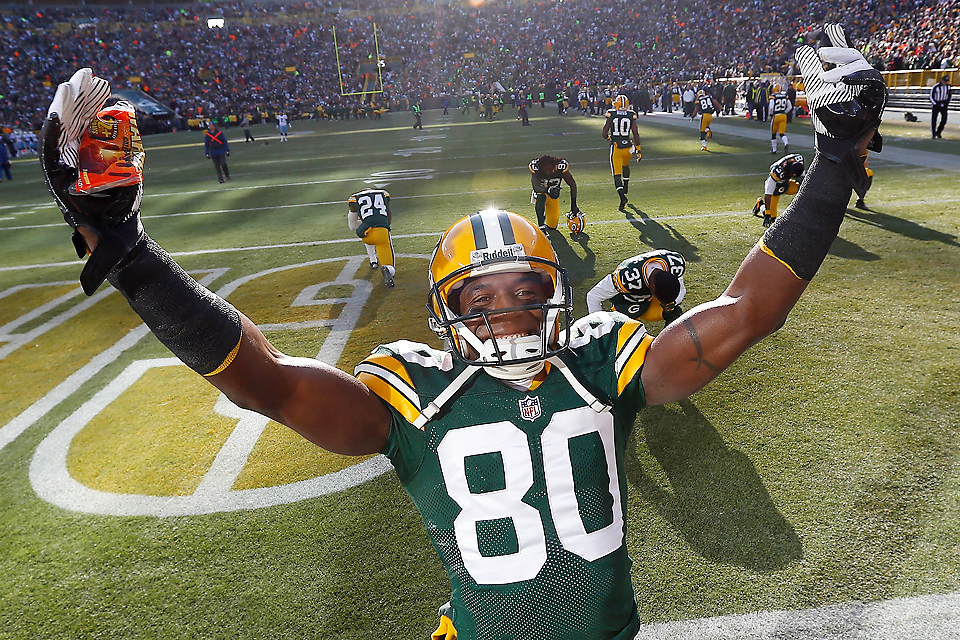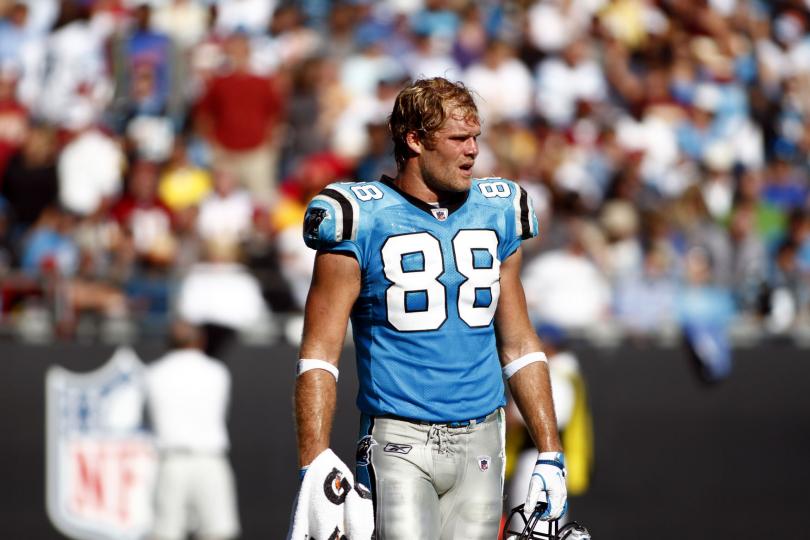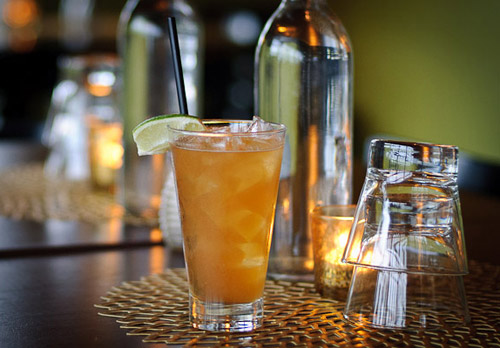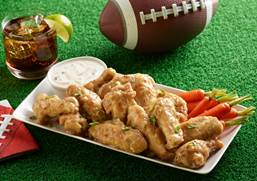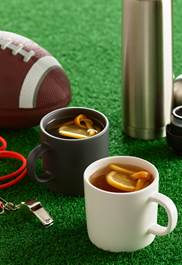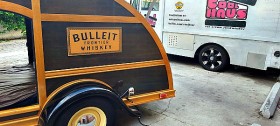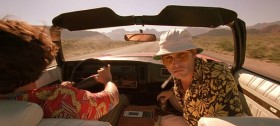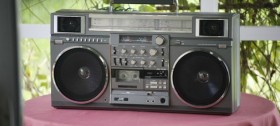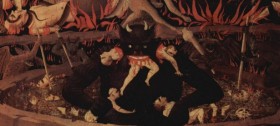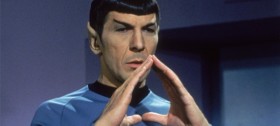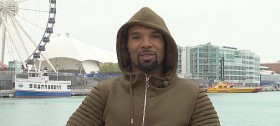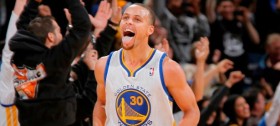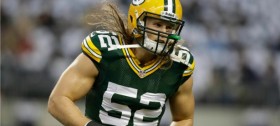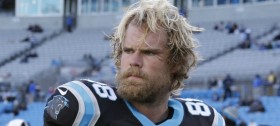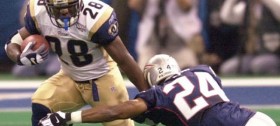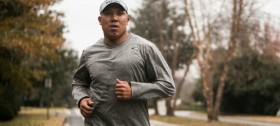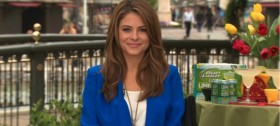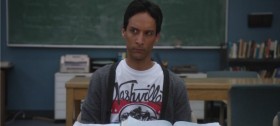Posts tagged NFL

adidas Puts A “Spring” blade In Sammy Watkins’ Step
adidas launches Springblade Drive in an aggressive spot with Buffalo’s Sammy Watkins. Shot using phantom slow motion, drone helicopter and infrared cameras that detect heat, the eruptive wide receiver explodes off the turf and speeds through stadium stairs.
The simplified silhouette features a 360-degree engineered air mesh upper and a suede tongue and collar for additional breathability, comfort and premium details. Inspired by the Energy Boost 2, the one-piece heel to mid-fit cage provides extra stability. The shoe’s 16 individually tuned blades instantaneously react to any environment, compressing and releasing energy. For the first time, the blades come to life through vibrant color application.
Springblade Drive is available Wednesday for $180 at adidas.com, adidas Sport Performance stores and select retailers nationwide.
Jun 24th

Antrel Rolle Works Out The Media
New York Giants safety Antrel Rolle teamed up with Promax Nutrition protein bars to host a workout with Henry Hynsoki and Spencer Paysinger at NYSC in Mid-town earlier this month. Some members of the media had a chance to work out with Antrel and the rest of the crew.
I was able to ask Antrel a few questions on the workout with Promax Nutrition and his time in the NFL.
Art Eddy: You worked with Promax Nutrition bars for an extreme workout. Tell me a bit about the event?
Antrel Rolle: The event was to show some of the workouts that we do on a day to day basis. We did some speed, agility, and strength drills. Just a little preview but we definitely got them to break a sweat. Doing these workouts you are burning off energy, so Promax Nutrition protein bars are perfect to keep your energy levels up throughout our long days of practice.
AE: Were the exercises that you guys did similar to your own workouts to get ready for the NFL season?
AR: Definitely. These are some of the warm-ups and drills we do at the facility and even now in the offseason.
AE: Speaking of the NFL you and the rest of the New York Giants reached the top of the NFL mountain when you guys won Super Bowl XLVI. How long did it take for that win to sink in?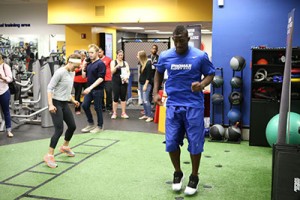
AR: In the moment everything was happening so fast that it took me a few days to realize what had just happened. One of the best memories I will have.
AE: Your position is defensive back. In a league that has a major focus on passing the ball what are some of the major things that you look to focus on as you prepare week in and week out?
AR: I study my tapes and learn the ways of the receivers. I like to know how my opponents think so I can prepare for them. I constantly work on my speed and receiving as well.
AE: Is there a player that challenges you the most on the field?
AR: The guy who challenges me most on the field is LeSean McCoy. He is the hardest guy to tackle in the open field of play.
AE: Last season you had a great season with six interceptions and two sacks. What type of goals do you set for yourself before each season starts?
AR: I like to take things one game at a time. The ultimate goal is to get to and win the Super Bowl of course, but I have daily goals and weekly goals that I set for myself throughout the season. Gotta push through and be better than the day before.
May 21st

Waiting For The Call On Draft Day
Every pro football player remembers what it’s like to receive “The Call.” That suspenseful moment when you wait to hear your destiny as a lover of the game. It’s the moment on which everything hinges. Pro football champion Richard Sherman has an inspirational congratulatory message for the young men who will make the cut this year. At Oberto, they believe what you put in your body and your life directly affects what you get out of it. That’s why their tasty all natural beef jerky has no preservatives or artificial ingredients.
As Richard Sherman says, “Big day for the guys in the draft. It doesn’t matter if you are the 1st or the 254th.”
#YouGetOutWhatYouPutIn.
May 7th

Boomer Esiason Chats With MANjr
Boomer Esiason played 14 great years in the NFL. He played for a total of three teams, the Cincinnati Bengals, the New York Jets, and the Arizona Cardinals. In 1988 the four time Pro Bowler won the NFL MVP award. Even after retiring from the game, Esiason is still making an impact on the NFL.
Boomer can be seen during the football season on CBS breaking down the game. He also is on the radio as a color commentator for Monday Night Football. He even has a morning show on a New York sports radio station called “The Boomer and Carton show.”
Yet if you ask Boomer what he is most proud of, he would probably say all the work he does through his organization, The Boomer Esiason Foundation. The foundation looks to support and improve the lives of those who have Cystic Fibrosis. His son, Gunnar was diagnosed with Cystic Fibrosis in 1993. Boomer used his popularity to raise awareness for the disease to not only help his son, but other children who have CF.
I had the great pleasure of talking with Boomer about his foundation, his time in the NFL, and more.
Art Eddy: You played 14 years in the NFL. What sticks out the most to you from your great career in the league?
Boomer Esiason: Well for me and I think most of the players will tell you the same thing. It is really the relationships that you develop when you play for different teams. Now for me I played in three different cities, in Arizona, New York, and Cincinnati. You develop these close relationships with coaches, players, and front office people. Those are the memories that you hold on to for a lifetime. Even when you are going through tough times Art. Whether it be a bad season with the Jets or Bengals or going to the playoffs and Super Bowl, or throwing for over 500 yards in a game with the Cardinals I always say the positive memories always outweigh the negative ones.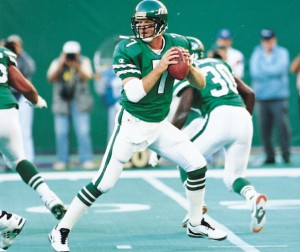
When you play 14 years there will be all sorts of emotions that you are dealing with. For me I always think back to all the great relationships that I was fortunate enough to make. It wasn’t just for what the NFL did for me as a player, but as a person too. In my world now with broadcasting I don’t think I would be doing what I am doing if it wasn’t for the 14 years I spent in the NFL.
AE: From watching you on the field and now hearing you breakdown the game on TV and the radio I know that you have a team mindset, but winning the MVP in 1988 had to be up there as one of the all-time greatest moments for you right?
BE: It was, but it was also a little bit embarrassing. I used to say back then and I say it today. An MVP award in an ultimate team sport like football really doesn’t make any sense.
I am a voter for the MVP award now that the AP gives out. I take that vote pretty seriously. This year it happened to be Peyton Manning. He would be the first to tell you that he wasn’t able to accomplish the things in his five MVP seasons without the teammates and coaches he goes to work with every day. That is how I felt when I won my MVP. While it is certainly displayed proudly in my home I will tell you that I owe a lot to the players and coaches in 1988 when I did win that award.
AE: Not that many people get a chance to play quarterback in the NFL. I think the role of the quarterback is one of the hardest positions in all of sports. As a fan of the league can you walk me through what you experienced as a quarterback?
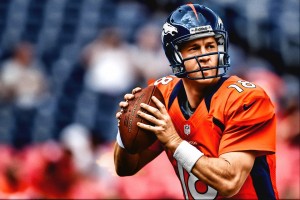 BE: It is an amazing responsibility. I take the upper echelon of the quarterbacks today like (Tom) Brady, Manning, (Drew) Brees, (Aaron) Rodgers, and (Ben) Roethlisberger. They are on a different plane than the bottom half of the league.
BE: It is an amazing responsibility. I take the upper echelon of the quarterbacks today like (Tom) Brady, Manning, (Drew) Brees, (Aaron) Rodgers, and (Ben) Roethlisberger. They are on a different plane than the bottom half of the league.
The reason that they are on that plane is that they not only understand how the game is played on the field, but how to carry themselves in the locker rooms and in the meeting rooms. Not only do the put accountability on their shoulders, but they hold their teammates accountable. They do that by more with their actions than words.
When the team wasn’t doing well the last thing that my team wanted to hear from was me. So I would go out and practice harder. I would try and challenge players on the practice field. Hopefully that would turn up on Sunday or Monday night when we were playing into a winning football game.
I always say that about quarterbacks. It is certainly about how you can communicate verbally, but it is really your ability to communicate through your actions. That is when you don’t need words to describe what you are doing or what you are trying to get done. Other players will react to that. That to me is the genius of one Peyton Manning.
AE: During your career when the game was on the line did you have a go to guy that you knew would deliver?
BE: Well yeah you do. It is somebody that you really, really feel comfortable with. For me I had a couple of those guys. It was Cris Collinsworth and Rodney Holman back in my days in Cincinnati. When I was with the Jets it was with Rob Moore. Fortunately for me I had Rob Moore as a receiver in Arizona too.
When I went back to Cincinnati there were younger players that I really didn’t know that much about. I knew that I could have a profound impact on their careers by doing what I just said. I would show them how to prepare and how to use that preparation on the field and turn it into a success.
When I think back about my last year in the NFL I had a running back who was a rookie that year. He had a phenomenal rookie year. That rookie was Corey Dillon. I think about how Corey Dillon became a great running back in the NFL. I hope in some small way that I helped him become a success in the NFL. After I retired Corey continued to have a great career and even won a Super Bowl with the New England Patriots.
That is what I think quarterbacks are known for by helping players become great. Hopefully when people think of me that they will say that I had an impact on their career to make them successful in the league.
AE: During football season people can see and hear you pretty much everywhere. You are on TV, the radio for Monday night football, and you have a morning talk show on the radio as well. You do a great job breaking down the game. With that you are very busy during the NFL season. I do have to say though you must have great time management skills.
BE: (Both laugh) I guess so, but I love the fact that people feel good about me to employ me in such high profile jobs. I will never ever take for granted the opportunity to speak about something that I love so much. The NFL has been great to me.
Covering the NFL is the ultimate for a football junkie like myself. I don’t have to coach. I don’t have to be a general manager. I don’t have to make those fourth and one decisions that a (Bill) Belichick or a Tom Coughlin have to make. Then on Sunday or Monday I can sit in judgment about those decisions and be able to sleep at night and not worry about it with any repercussions. (Both laugh.)
AE: Your son Gunnar was diagnosed with Cystic Fibrosis in 1993. You and the many great people at your foundation have done so much for the CF community. For those who don’t know too much about your foundation can you give an overview? 
BE: I was actually exposed to Cystic Fibrosis in 1989 by Frank Deford. Frank was speaking at a banquet that I was at. He had lost his daughter Alex to Cystic Fibrosis. Cystic Fibrosis is a genetically transmitted disease. My wife and I didn’t know that we carried the recessive gene trait.
The disease itself involves the lungs and the digestive system. The lungs are marked with bacterial infection. Saying all of that when Gunnar was diagnosed in 1993 at the age of two when I became the quarterback of the Jets the second phone call I made was to Frank Deford. He was just as shocked as I was that destiny and irony had found our family when Gunnar was diagnosed with the disease that ultimately killed his daughter.
He said that this was God’s way of saying that we have an opportunity here. To use your celebrity in New York to raise funds and awareness for Cystic Fibrosis. I have never ever not taken that piece of advice as seriously as it deserved to be taken. I feel really strong after 20 years of watching Gunnar grow up and graduate from Boston College that we have taken Frank’s ideas and trying to create a world for Cystic Fibrosis patients to live a healthy, normal, and productive life as any child in the world.
I can say that watching Gunnar fight this disease every day that I am most proud as a dad of what he has already accomplished in his young life. I want him to become a father himself. As any father can attest to that there is nothing more fulfilling and greater than becoming a father. So for me we are trying to make a difference in the lives of Cystic Fibrosis patients. Gunnar is a prime example of that. I think we have accomplished our mission, but the ultimate goal is to cure this disease but we are still a ways from that.
AE: How has research and medicine evolved since the early 1990s?
BE: Well a number of things have come to fruition. First and foremost if people want to find out more about Cystic Fibrosis they can go to our website at Esiason.org or they can go to the National Cystic Fibrosis Foundation website, which is CFF.org.
In the past 20 years we have raised the median age. The average lifespan with Cystic Fibrosis was from 19 to now 37. Which in a greater understanding of the disease there are better ways to handle the symptoms of the disease. Lung transplants are more commonplace than ever before. We ask people and beg people to become organ donors because you never know when you can have the positive impact on somebody else’s life. You can give them a second chance at life, which I have seen and lived through many times over in the world of Cystic Fibrosis.
The drug from the patient to the test tube has been fast and furious over the last 20 years. There have been at least six or seven new therapies that Gunnar and all Cystic Fibrosis patients have been benefitting from. There is a better understanding of the disease, the symptoms of the disease, and the drug delivery in terms of the types of infections these kids are dealing with.
Even though it is not easy living with Cystic Fibrosis as Gunnar has proven and many young adults like him have proven it is an attitude that you have to have. You got to be positive. You got to be realistic. You got to be aggressive in dealing with the disease. That is one of the reasons that we are seeing kids live a lot longer. We are seeing female CF patients being able to deliver their own babies and becoming moms themselves. It is really becoming quite the story.
We have a number of CF patients that run in marathons. The story of triumph in the world of Cystic Fibrosis has really been nothing short of a miracle thus far. We continue to see miracles each and every day. We are going to continue to fund the research, college scholarships, lung transplant grants, and every other aspect of Cystic Fibrosis that we can improve we will continue to do.
May 5th

Donald Driver Talks With MANjr.
Donald Driver didn’t just make an impact in the NFL, but he did off the field as well. Growing up as a kid Donald and his family faced tough times. Driver took that adversity and used it as motivation to create a better life for himself. Football fans know the mark he left not only in Green Bay, but throughout the league. The four time Pro Bowler helped the Packers win Super Bowl XLV in 2011 as Green Bay beat the Pittsburgh Steelers 31-25.
The Green Bay Packers Receiving Yards All-Time Leader also won the Ed Block Courage Award. This award is given to players, who are voted by their teammates as role models of inspiration, sportsmanship, and courage. Driver continued to inspire people when he created the Donald Driver Foundation in 2001. The foundation helps families find homes, assists in educating kids, and helps recognize those people who do wonderful things in their community.
Driver is an accomplished author as well. His book “Driven” was on the New York Times Best Sellers list. He has also written three children’s books. Each book focuses on a challenge a kid or an adult may experience in life. He will have another children’s book out later this year called “Quickie Handles a Bully.”
Art Eddy: Many players who get drafted in the late rounds have chip on their shoulder. How much of a factor was that for you to prove that to the teams that passed on you that they made the wrong choice picking someone else?
Donald Driver: In 1999 when I got drafted that was the first thing I did. Teams told me that they were thinking about drafting me the first day. Then they would say we would draft you the second day and you shouldn’t go no later than the fourth round.
So when all these teams are calling you to tell you that they are going to draft you, but you sit there during the draft at home with your family and the first day goes by and you don’t get picked up. The next day comes and you don’t get picked up again and you basically think your career is over.
Now you have to go and find a normal job. I had that chip on my shoulder. When the Green Bay Packers called me in the seventh round after 32 receivers got taken before me I just wanted to prove to the league and to the other teams that they made the wrong choice. They should have drafted me earlier. The Green Bay Packers took a chance on me and that is why I was able to retire with them and give them a legacy instead of another team.
AE: Can you describe your emotions and memories from your first NFL game?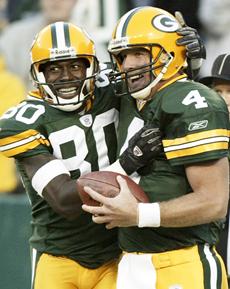
DD: Oh wow. My first memory that I actually made it in the NFL was our first family night scrimmage in Green Bay, Wisconsin. I remember Brett (Favre) sitting down with me and telling me that this wasn’t Alcorn State University where you only have 20,000 people. It is going to be about 60,000 people in those stands.
I remember walking out that tunnel just for that family night scrimmage, offense versus defense and there were 57,000 fans in the stands. They were yelling and screaming. From there I was just going nuts. I remember Brett and I walking out of the tunnel and he said to me, ‘Hey Drive, welcome to the NFL.’
I had an amazing practice that week. I was catching everything. I think from there it solidified my opportunity to make it on the Green Bay roster.
AE: As fans of the game we all know that Lambeau Field is one of the most iconic stadiums in all of sports. For you who played there, what does Lambeau Field mean to you?
DD: It means everything. If you never had the chance to experience Lambeau you should go to a game. I don’t care if it is a cold game or a hot game. You want to be there. You want to experience the atmosphere. The fans have been great throughout my entire career.
They have proved to me that they have shown their loyalty to me. For me it was to show my loyalty back to them. They have been supportive through my charity, through my family, and to be the person that I am today. I have always said this. My fans have put me on a pedestal. It wasn’t me playing that put myself on that pedestal. When they put you on a pedestal you always have to remember that you are no better than they are.
AE: Who does the best Lambeau Leap?
DD: You know I think a lot of people have given me that title. They say I do the best Lambeau Leap because one time I remember playing the Detroit Loins at home. I scored a 60 or 70 yard touchdown. I ran and I looked up and I saw the Detroit fans. When I jumped up they were trying to catch me. So I jumped down and then took two steps over and then jumped back up. (Both laugh.) I went back into the Packers’ fans hands and I stuck my tongue out at the Detroit Lions fans. It was a great, great time. It was an amazing experience.
When I scored my first touchdown I had no clue that everybody should do the Lambeau Leap. I 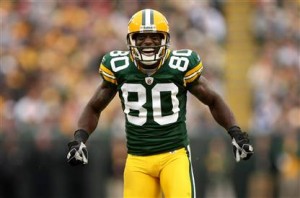 thought it was just LeRoy Butler’s thing. I didn’t want to step on his toes. So I didn’t do it when I scored my first touchdown at Lambeau. I remember getting to the sideline and so many guys gave me grief. They told me that the next time I score I better do the Lambeau Leap. Since then every time I scored I would do the Lambeau Leap.
thought it was just LeRoy Butler’s thing. I didn’t want to step on his toes. So I didn’t do it when I scored my first touchdown at Lambeau. I remember getting to the sideline and so many guys gave me grief. They told me that the next time I score I better do the Lambeau Leap. Since then every time I scored I would do the Lambeau Leap.
AE: What was the toughest part about playing in the NFL?
DD: For me it was just the speed of the game. Coming from Alcorn State, college is just a different atmosphere. The speed of the game is just so much faster. So I wanted to make sure when I got there I just learned and learned. I would sit back and learn from all the veteran guys and took what they said.
They told me that I needed to stay focused and make sure to make every play count. The opportunities are slim. In college you could always make it up. In the NFL it is hard to do. They taught me that. I was able to use that year after year.
AE: Which safety or cornerback challenged you the most? Who did you love to play against?
DD: I will say this. I played against a lot of great corners. Antoine Winfield, Champ Bailey, Deion Sanders, Kevin Smith. I mean the list goes on and on. DeAngelo Hall, Charles Woodson, Al Harris, Mike McKenzie. That list continues to grow.
Every week I knew when I stepped on the field I had to play my best game. The good thing is that I was able to play with some great corners. Mike McKenzie was there before he went to New Orleans. Charles Woodson played in Oakland before he played in Green Bay. Al Harris was in Philly before playing here. I played against those guys, but I knew them as well and they knew me.
Every day at practice I knew that if I could beat them then I knew that I was going to have a great game. There was no one else out there that was tough enough to stop me. That’s the way I played the game. I knew if I could beat my guys one on one in practice that I could do that in the game. That is what I did. I was able to step up my game a bit more.
AE: I am guessing that your answer will be winning a Super Bowl title, but is there one moment that sticks out the most in your great NFL career?
DD: I have so many moments that I will always cherish. The Super Bowl is a moment that I think every NFL player would want to reach. That is the greatest milestone for us. To win that Super Bowl title and to have that Super Bowl ring on our finger will let us always cherish that forever.
When I became the all-time Packers receiving leader in franchise history it solidified my legacy in Green Bay. There were so many great players like James Lofton, Don Hutson, Sterling Sharpe, Antonio Freeman, and Robert Brooks. All those great players played before me. For me to be on top of that list now, that stat stands the test of time.
I know that someday a player might come in and break my record. I hope it never gets broken. I hope it stays there forever. That is the same thing that Sterling and James Lofton thought. Those guys hoped that their record would never be broken. That stood for almost 30 years, but look what happens now. I guy steps in and breaks those records.
You just never know. The way the game is played now those records will be broken. Those are the things that I know I will cherish, the record breaking, the Super Bowl, and the fans.
AE: Two things I want to touch upon from what you just said. One, I appreciate your honesty about your record not wanting to be broken, and two….
DD: Yeah, right. I don’t want anyone to break that record. I can be honest about that. (Both laugh.)
AE: Also two, you probably get this a lot with all the catches you had in your career. I want to thank you for your work on the field. You helped me win a few fantasy football championships when I drafted you.
DD: (Both laugh.) You are more than welcome on that.
AE: Tell me about the great work you and the great folks at the Donald Driver Foundation do especially with the “Driven to Achieve Awards”.
DD: We started the foundation back in 2001. We wanted to give families the opportunity to have a better life. We created the Donald Driver Foundation to help families in homeless shelters transition from homeless shelters to houses, where we pay subsidized rent for them from six months to a year.
We also came out with a computer scholarship as well as an academic scholarship. We give kids that are either going to a two year or a four year college either a $1000 scholarship or a computer scholarship. They must maintain a 3.0 GPA and they must do community service.
We also started supporting a program called Blessings in a Backpack. We give kids the opportunity to have food on the weekends. We have seven schools that we help supply with that. There is a three year commitment. It only takes $80 to feed a child for the entire school year. So we have been blessed to help over 1,000 kids.
We just launched the “Driven to Achieve Awards.” It is something that I came up with to give so many people an opportunity. So many people are doing great things in this world that don’t get recognized for what they do. I wanted to take the shine off myself for a while and put a shine on those great people.
We have honored eight great recipients to receive that award this year. We had six local winners from Wisconsin and two national winners. Our two national winners were Gladys Knight and Anthony Robles, the Arizona State wrestler.
It shows you that when you continue to go great things in the community people support you. I have had so much love and so much support throughout this all that I could not have this without all my fans and all my sponsors.
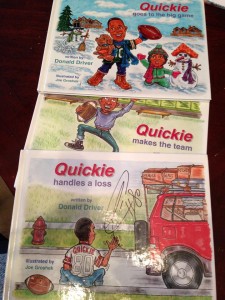 AE: You have written three children’s books and another one is scheduled to come out this year. What inspired you to write these books?
AE: You have written three children’s books and another one is scheduled to come out this year. What inspired you to write these books?
DD: What inspired me to write these books was when I was telling these stories to my son when he was two years old. He was lying in bed and kept asking questions. He would ask if I played sports and if I played football. I told him that I play football for a living. At two years old they might not understand that you are playing in the National Football League. I kept on telling him the stories of how everyone kept telling me I was too small to play football. I was too small. Choose another sport. You are going to get hurt.
One of my good friends said that I needed to start writing a children’s book. Every kid in the world is going through that. Either their mom is telling them, or their teacher, or a friend is telling, or an older sibling is telling them that. You need to put that in a book so a kid can understand that you can make the team. That is why I created “Quickie Makes the Team.” Quickie was a kid that nobody believed in that could play football, but he believed. He tried out for the team and made it. At the end of the book he wins the game for the team.
The second book was “Quickie Handles a Loss.” Regardless of what you may face in life, whether it is losing a job, failing a test, losing a loved one in your life, do not let that dictate how you live your life. Continue to strive and move forward. It only gets better. It doesn’t get worse.
Then I came out with “Quickie Goes to the Big Game.” As an NFL player the greatest milestone for a player is to make it to the Super Bowl. Quickie gets to go with his dad to a place where his dad has been dreaming for a long, long time to go to. That is the Super Bowl. That story is whatever you dream of, continue to dream. Your dream will come true. Dreams come true if you put the effort into it.
The book later this year is “Quickie Handles a Bully.” Everyone out there faces a challenge. Whether it is a kid getting bullied at school or an employee getting bullied at work by his boss, every single person is having that issue. I want my kids to know that it is not okay to be bullied. So I put that message in this book. You hurt bullies with kindness. You don’t have to fight back unless he or she puts their hands on you. That’s why I wanted to create this book. It can be a conversation.
May 5th
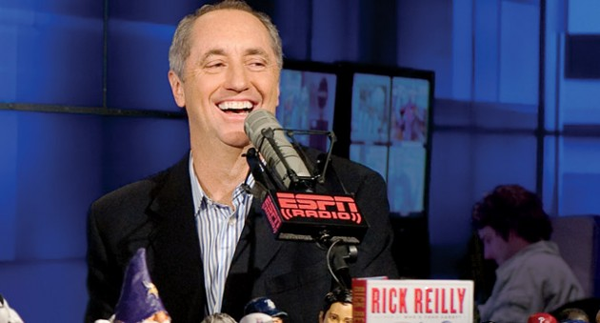
ESPN’s Rick Reilly Tells Us What To Expect From His New Book
Growing up in high school besides the text books and novels I had to read for school most of my reading material consisted of comic books. That was until I started reading Rick Reilly’s column in “Sports Illustrated.” Rick has a way of telling a story that perfectly intertwines sports and life. Rick has been voted NSSA National Sportswriter of the Year eleven times. He currently writes for ESPN, but will be stepping down from that role on July 1st.
On May 13 you can get his new book, “Tiger Meet My Sister: And Other Things I Probably Shouldn’t Have Said.” This book is a collection of his work that even has a postscript section after each story to let the reader know if anything has changed since he posted each story.
I had the pleasure to chat with Rick about his new book, how Muhammad Ali played many pranks on him, best and worst interviews, sports, and more.
Art Eddy: I am loving your latest book. The forward/obituary sections were amazing. I am guessing since you are a writer you may have written your obituary a few times right?
Rick Reilly: (Laughs.) When you have to write a weekly sports column, which I feel like I have been doing since I was 20, you just go through dozens and dozens of ideas every week. Sometimes they don’t work out. You kind of hide them. I have this file on my computer that has about 500 ideas. Out of those 500 ideas 300 of them have been started and then abandoned.
I have probably worked on my obituary about ten different times. I was thinking okay I got nothing else this week, so let me try the obituary. Finally I thought this would be the perfect forward because beginning July 1st I am giving up the sports column for 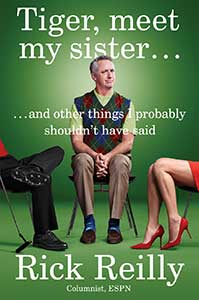 good. I am just going to write books. So I thought hell why not eliminate the middle man and write your own obituary. It was really fun. It was really fun to look back on your life and say it wasn’t that bad.
good. I am just going to write books. So I thought hell why not eliminate the middle man and write your own obituary. It was really fun. It was really fun to look back on your life and say it wasn’t that bad.
AE: The section where you talk about fortitude when small people act big was very inspiring. From all that you have seen which story will always stay with you?
RR: Over my career I have found that those are the stories that I like doing the best. When you write about small people doing big things and overcoming things. There was this kid I wrote about who refused to give up running for the cross country team. He was a high school kid. It took him 35 more minutes than his teammates because he had cerebral palsy. The right side of his body didn’t work. He kept falling. In cross country you are going over fields and streams.
His face was all scarred up from these falls. His parents begged him to quit. So did his coaches. He wouldn’t quit. Pretty soon his teammates would go out there and finish the race. Then they would go back a mile and a half and finish with him. Pretty soon the girl’s team started doing. Then the cheerleaders started doing it.
Then at the last meet that he ran the opposing teams did it. At the finish line it was a bunch of crying parents. That kind of column sticks with me. I would say that there are five of those in this book.
AE: You have a section in your book about how some of your articles got you into hot water. For those articles how do you make up your mind whether to publish a story or not?
RR: Truth. You try to tell the truth. Sometimes you fail and get it wrong. I think I have published over two million words in my 37 year writing career. So you are going to screw up. Especially if you are an idiot like me you are going to screw up a lot. So the times you regret the most is when you accidentally misquote someone. Or when you realize later when meet someone you didn’t paint the right picture of them.
Sometimes you get into hot water, but you would still do it again. I think of Sammy Sosa, who at the time around 1998, was saying that he couldn’t wait for drug testing. He couldn’t wait for steroid testing. He said, ‘I am going to show all you people  that my numbers are real.’
that my numbers are real.’
I said to him, ‘I found a drug testing lab ten minutes from Wrigley Field. You don’t have to wait for drug testing. Let’s do it now.’
He flipped out. He started screaming at me in Spanish. He started grabbing this baseball bat and threatening me. I was like hmm, someone doesn’t want to be tested. His point was about the (baseball players) union. It was sort of a mild post in a steroid story. He freaked out at the idea of being tested. As we know he did show up on a steroid failed test list. He shrunk by about 40 pounds as soon as he got out of baseball. His best friend was busted with 20 thousand dollars’ worth of steroids in the Dominican. I was in hot water for months over that, but I thought I was right.
AE: I have been a big fan of your work since I found your column in “Sports Illustrated.” Love the way you tell a story. How did you hone your craft as a storyteller?
RR: Thanks for saying that because I am 56 years old, but people come up to me like I invented the printing press. They will say, ‘I was 13 years old and that was the first reading I ever did. You taught me how to read.’
I am like come on. I am not “Dick meets Jane.” I was like you. The first really good reading I ever did was sports. It was a guy named Jim Murray. He was this great columnist for the “L.A. Times.” He wrote sentences that I have never seen before. They just jumped off the page and punched you in the nose. There were sentences and you would be like how did he do that?
I would read it over, over, and over again to see how he did it. It would be things like, ‘John Wooden is as square as a pan of fudge.’ Or things like, ‘Gentleman start your coffins.’ That is what he said once at the start of the Indy 500. This was a whole new way to write. That guy became my friend, my mentor, and my hero when I went to the “L.A. Times.” He said, ‘Make the writing 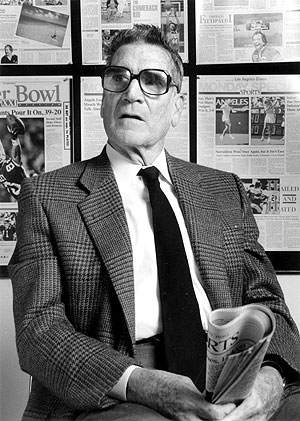 fun. There is no city ordinance. No one has to read you. They have got to want to read you.’
fun. There is no city ordinance. No one has to read you. They have got to want to read you.’
That was what stuck with me more than anything else. Make them want to read you. Make it fun. Don’t make it a job. That is how I tried to write from then on.
AE: Who has been the best person that you have interviewed and who has been the worst?
RR: Charles Barkley would be one through four. Then playing golf with Bill Clinton when he was the standing President was fascinating. I have never been around someone with that much charm, knowledge, and wit all wrapped in one. I know people think he is some kind of redneck hick, but this guy knew more about the world which I learned in four hours of golf. I thought he was really fascinating.
Another fascinating interview was with Mike Tyson. You didn’t know if you were going to get out of there with a punched eye or you were going to be his best friend or you were going to do crystal meth. You didn’t know if he was going to threaten you. You think anything could happen.
I always found him so fascinating because he was always so self-loathing. Yet in so many ways he was sort of an idiot savant. He knew more about Mao Tse-Tung and rebels in China and boxing, but he could hardly make his car payment.
So if you talk about most interesting interviews like Mohammad Ali when you would get him in the morning and he could still talk to you. He played tricks on you. One time he pretended to fall asleep during an interview with me. It was just me and him in this room. At that point I was like okay I guess I will just read this magazine. Two minutes later he dove across the couch and choked me. It was all a fake. So guys like that are things that I will never forget.
The worst. There have been so many bad interviews. Some people just start with a chip on their shoulder. Reggie Jackson started off that way. Sam Snead was terrible. What is funny is that some of these people who have never been interviewed are the worst. They say no comment. Dude you are really never going to be interviewed again so you better make a comment.
AE: Is there a person that you have tried to interview and to this day you are still trying to get?
RR: To this day and I can’t get him anymore was Johnny Unitas. The great quarterback would charge money for an interview. We weren’t ready to do it. Well I was ready to do it because I thought that alone was worth a column. That was a guy that I was never able to get. The companies that I worked for refused to do it. I can see why, but still. Wouldn’t it have been fascinating to interview Johnny Unitas and pay for the privilege?
AE: Recently you tweeted out that you are giving up your column at ESPN. How tough of a decision was that? 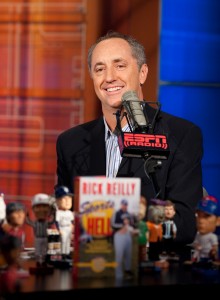
RR: Not tough. Not tough. I have been doing this for a living since I was 19 years old. It has always been sports. It has never been anything else. It is kind of like when a dog as an electric fence and finally the owner dies. The dog is like can I really leave this yard?
I could have left the yard about five years ago. I said okay I will go five more years and that is when I did this ESPN thing. I have been dying to try and write music, movies, politics, travel, and I want to do books. I have written 11 books. Three of them have been novels. I love the novels because the characters say stuff that you are laughing at the things that they are saying. And it is coming out of your fingers. So that is a really fun experience. We are going to live in Italy for six months. There is just a whole new life waiting out there for me. I am not dying. I am still going to write. I am certainly not going to write that much sports.
AE: Well maybe writing your obituary in this book might not have been the best thing since people might think you are dying.
RR: Yeah, they might really think that I am dead. A lot of them wish I were.
Apr 28th

Greg Olsen Interview
Greg Olsen plays in the National Football League as a tight end for the Carolina Panthers. He started his career with the Chicago Bears in 2007. He has been through a lot in the league, but he had his toughest challenge off the field. During the offseason in 2012 Greg and his wife, Kara were ecstatic when they received the great news of Kara being pregnant with twins. They already had one son and now their family was about to get bigger.
Sadly they got news that one of their babies would be born with a severe congenital heart defect (CHD), called Hypoplastic Left Heart Syndrome. Thankfully Greg and Kara went to Levine Children’s Hospital where both babies were born. Their son TJ has CHD and he needed a few operations on his heart. Now almost a year and a half has passed and TJ is doing well.
The Olsen’s wanted to help out other families who would deal with CHD. They set up “T.J.’s ‘HEARTest’ Yard” program under their Receptions for Research foundation. This program provides families of babies affected by CHD with many programs that include in-home, private nursing care, physical therapy and speech therapy as well as more outstanding services.
Greg was kind enough to chat with me about his family’s journey with TJ and CHD, his foundation, and a bit of football.
Art Eddy: The second week of February is CHD Awareness Week. I am very grateful for you to take the time and talk about how CHD impacted your family. Two years ago when you found out that TJ had CHD what was going through your mind at that point? 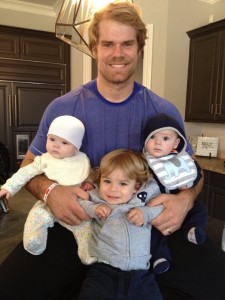
Greg Olsen: It was scary. Up to that point we really didn’t know anyone who had a congenital heart defect. We got the news that he was going to be born with a serious heart defect called Hypoplastic Left Heart Syndrome. It came to us as a great shock. We were obviously scared. There was a lot of uncertainty. It was something as a family that we had to work through.
We have had unbelievable doctors and the care that our son was able to have here. We were very fortunate that he is almost a year and a half. He really has come a long way.
AE: Reading up and watching videos on your family’s journey it looks like TJ’s battle with CHD made you guys a stronger family. You don’t sweat the minor things. It is incredible to watch the strength that these kids have as they battle with CHD. As a father how did you try and keep it together for the rest of the family while TJ was going through his procedures?
GO: It was hard. We had our weak moments. We definitely had our moments where we could have handled it better. You just try and do the best you can. We took it one day at a time. We would try not to get ahead of ourselves trying to predict the future.
That worked for us. Worrying about the moment now. What is the best thing that we can do for the long term health of our child, but what could we do today? It wasn’t what can we do in six or eight months. We got the diagnosis early before the babies were born. It gave us a lot of time to help prep ourselves. It also gave us a lot time to sit back and worry. It was a tough time there before the babies were delivered.
Once they were delivered I think it was nice to just move forward to the surgery. At that point it became real as opposed to just sitting around waiting.
AE: I really appreciate all the work you and your staff do for your foundation Receptions for Research. Tell me a  bit about the foundation and T.J.’s ‘HEARTest’ Yard.
bit about the foundation and T.J.’s ‘HEARTest’ Yard.
GO: Receptions for Research is our family’s foundation. In the past year or so we started the “HEARTest Yard” program with Levine Children’s Hospital here in Charlotte. This is where TJ has had all his surgeries. That is where we have gotten all our medical care.
We approached them about starting a cutting edge, never been done before privatized health care program. Administered by the hospital, but completely funded by us through our foundation. It is done either by us personally or by our fundraising efforts. It brings that world class care from the hospital and bridges it into the home.
That is the biggest thing that we felt we could have used. More help to bring in specialists. Bringing in nursing care. Bringing in physical therapists. All of those things. That is really the inspiration of what the program is. There is a handful of families that have already started in the program. We continue to get unbelievable feedback about the efforts to help the family’s peace of mind and more importantly the health and future of the baby. It really has been positively received and we are very excited about it.
AE: How can people help your foundation out?
GO: They can visit our website, Receptions for Research dot org. One of our main pages there will be the “HEARTest Yard” link. It will bring up all of our future events. It will give ways that people can sponsor. It will give a little more information about the actual program. It will give more information on what Hypoplastic Left Heart is. They can pretty much get everything about the foundation, the hospital, what actually HLHS is all on the website.
AE: How has becoming a dad changed you?
GO: You learn a lot as a person. You learn a lot as a family. It is the most scary, the most nerve racking, but also the best thing that has ever happened to me. Being able to come home and see these kids every day. All three of them run to the door now. They say hi and their eyes light up. It is just something special. Until someone is a father it is really 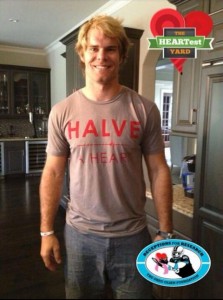 hard to explain it to them. I could go on for what it means to me. Especially what has gone on in our family over the past year has made it even that more special.
hard to explain it to them. I could go on for what it means to me. Especially what has gone on in our family over the past year has made it even that more special.
AE: What advice do you have for new dads out there?
GO: It is not going to be easy. There is no manual. It is not just come home and play catch all day. There is a lot of work. You need to put the time in to teach your kids on how they are supposed to act. Everything they learn is from you as their parent and as their dad. Especially the different relationships depending if you have a boy or a girl and the different dynamics that are in those relationships.
You kind of just learn on the fly. That’s at least what I did. You are not perfect, but you try to be the best you can for your children.
AE: Switching to the NFL. You and your team the Carolina Panthers started off rocky, but finished strong to get the number two seed in the NFC. What did you learn about your team this season?
GO: We really came along way. We were able to accomplish a few of our goals. We won the division. We were able to make it to the second round of the playoffs. We were able to accomplish some of our goals. Obviously we fell a little short of the ultimate goal of making it to the Super Bowl. It is something to at least build off of. We are eager to get started again and make another run.
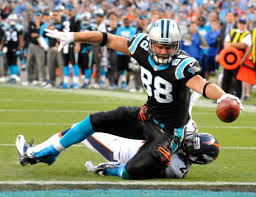 AE: When do you start to worry about the next season?
AE: When do you start to worry about the next season?
GO: Probably sometime in the next couple of weeks. I will start back up my training. Start getting everything lined up to get prepared physically and put all of that inline. I have taken the past few weeks just hanging with the family. Each day we take a few trips with the kids. Just trying to be around here and taking them to school, picking them up from school, and being there for dinner. That is something this time of the year that you have to take advantage of. I will get back to my training in a few weeks.
AE: Growing up did you have a NFL team that you would root for and did you have a favorite player?
GO: No I didn’t. I grew up in Northern New Jersey right outside of New York. So the New York teams were very prevalent up there. We would follow them there. They were the local games. So I guess them, but we were more into college football games. College football was something that was more on our horizon when we were growing up and getting into high school. I don’t think any of us could have imagined playing this long in the league. It is something that is incredible, but I don’t know if it was something I thought I could do all along. So I would say college sports was more of a bigger deal growing up.
Feb 11th

Marshall Faulk Interview
Even before Marshall Faulk played in the NFL many knew that he was going to be a superstar in the league. In college at San Diego State University Marshall was a three-time All-American. The Indianapolis Colts drafted him as the second overall pick in the 1994 NFL Draft. After his time with the Colts, he played for the St. Louis Rams.
Faulk is one of only three NFL players with at least 10,000 rushing yards and 5,000 receiving yards. Marshall has been named the league MVP, helped the Rams win Super Bowl XXXIV, and was selected seven times for the Pro Bowl. He was elected to the Pro Football Hall of Fame in 2011.
Faulk can be seen on TV shows such as “NFL Total Access,” “Thursday Night Football,” and “NFL GameDay Morning” on the NFL Network.
Before Super Bowl weekend I caught up with Marshall. He was working with Verizon to promote the “Who’s Gonna Win?” campaign in connection with the Empire State Building. Besides talking about that promotion we did chat about this year’s match up between the Seahawks and Broncos, his time in the NFL, and his induction into the Hall of Fame.
Art Eddy: You are part of Verizon’s “Who’s Gonna Win?” program, the first-ever social media-driven light show on the world’s most iconic building, the Empire State Building. Tell me a little about that promotion? 
Marshall Faulk: This whole “Who’s Gonna Win?” campaign is an initiative by Verizon. They are powering up the Empire State Building. Fans can help decide if their team’s colors will go up on the Empire State Building. It is a pretty cool program. Each day is going to be a different program leading up to Saturday.
Obviously everyone wants to know who is going to win. That is the interesting thing to see. Which team’s fans will get more involved and how many hashtags will be for Seattle or Denver is going to come into play. We will find out when the Empire State Building will be lit up.
AE: It sounds like a very cool program. Who do you think will win the Super Bowl? Broncos or Seahawks?
MF: I think it can go either way. I don’t have a favorite. Usually you can look at the numbers or watch how they play common opponents. It is so tough to tell. I keep telling people that only because Peyton (Manning) is a friend of mine that I just want to see him win another Super Bowl. Outside of that I really don’t know. I am not going to lie.
AE: Speaking of the Super Bowl you had the great fortune of playing in two of them. What was the week leading up to the game like?
MF: You want to say that it is all business. You are trying to have a normal week. Last night I saw that a bunch of players from the Seahawks have a team event. They showed some support for the (Brooklyn) Nets by going to the game. Those are the kind of things you want to do. Dinners, going to a basketball game, just things like that with your teammates.
Keep it in a team atmosphere. If you have family here, have dinner with your family. You don’t want to be that guy who is drawing negative attention to your team. That is what we are waiting for. We are in the media. We are trying to see who is going to be the idiot to try and do something stupid.
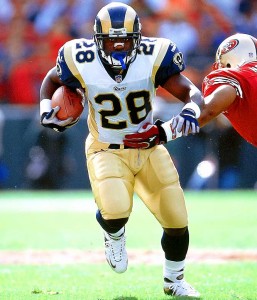 AE: When did the nerves go away when you played in your first Super Bowl?
AE: When did the nerves go away when you played in your first Super Bowl?
MF: Let’s see here. First you come out of the tunnel. You are excited about the game. You realize the magnitude of the game. You look around and see all the press. You look at the field and say ‘God this looks small.’
You hyperventilate. You catch your breath. Probably the second series after you get a hit a couple times and had a few times touching the ball.
AE: With everything that you have accomplished in your phenomenal career from MVP awards to a Super Bowl win what is the number one thing you take away from your time in the league?
MF: Winning the Super Bowl. I am telling you that it is the hardest championship to win. It requires all hands on deck. When you are on the field 11 guys must be pulling towards the same goal. It is the greatest team sport ever. It is the greatest sport ever. I just love how fun it is to win a championship.
The one thing that you know about our game and I love this as well, the best team doesn’t always win. It is the best team on that day. In other sports you get seven games to get it right. In our game you get one game to get it right.
AE: Can you imagine playing the best of seven for a Super Bowl? It would be crazy right?
MF: Exactly.
AE: After your time in the NFL you got the call that you would be inducted into the Pro Football Hall of Fame. What was the first thing that entered your mind when you got the news?
MF: I will take you through the whole process. When you first hear that you are on the ballot you are kind of nonchalant about it. It gets down to 35 and you are like alright. When it gets down to 15 you are pretty good. The week of the Super Bowl and pretty much that Saturday was when I started having the pregame jitters feeling.
They are calling names. I am standing up there. My hands are sweaty. My heart is beating. I am saying to myself you can’t go in the game. You are not playing, but that natural feeling of anticipation or excitement that you have when things are out of your control when you can’t do anything about it. That was what it was. I was quite relieved that my last name ends in F and it was called early out on the list. It was a good day to hear my name called. I will say that.
AE: You and your teammates on the St. Louis Rams had a sick nickname, “The Greatest Show on Turf.” What was it like to play with guys like Kurt Warner, Isaac Bruce, Torry Holt, and the rest of that high powered offense?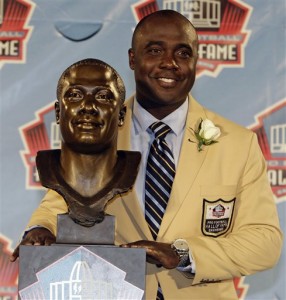
MF: It was fun. I enjoyed playing with those guys. As much fun as it was the one thing that we talk about when we see each other like we did at the Pro Bowl recently. Ricky Proehl, who is now the Carolina Panthers receivers coach, was at the Pro Bowl because the Panthers coaching staff was there for the Pro Bowl.
We just started talking once again. Ernie Conwell, he works for the NFLPA. Me, him, and Ricky were having the same conversation. We always talk about it. The one thing that continues to come up about it is how unselfish we were. When I look at the Denver Broncos that is what you get from them. They really don’t care who is catching the touchdowns, who is catching the passes, who is getting the yards, or who is getting the accolades. It is all about a team goal.
It is hard to get that especially from receivers. We had it. It was special. I definitely enjoyed playing with those guys. We talk about it. I always point to Ricky Proehl. The year before Ricky led the team in receptions, receiving yards, and receiving touchdowns. The year we won the Super Bowl he catches one touchdown. It was touchdown that sent us to the Super Bowl against Tampa in the NFC Championship. He doesn’t say a word about it the whole season. That is the unselfishness you need in order to win games like that.
Feb 3rd

Marshall Faulk and Other NFL Greats Ask #WhosGonnaWin
This week Verizon is getting you involved in Super Bowl Week with #WhosGonnaWin. Fans have enjoyed watching NFL teams light up scoreboards all season long, but during Super Bowl week, fans will be the ones lighting up the Empire State Building as part of Verizon’s WhosGonnaWin program, the first-ever social media-driven light show on the world’s most iconic building, in partnership with Empire State Realty Trust.
 The five-night series, curated by the Empire State Building’s world-renowned lighting designer Marc Brickman, will showcase the colors of the two Super Bowl XLVIII teams, the Denver Broncos and the Seattle Seahawks, based on fans’ tweets to the question #WhosGonnaWin. Flipping the switch nightly will be current NFL stars Drew Brees and Matt Forte, along with NFL Hall of Famers Barry Sanders, Curtis Martin and Marshall Faulk, who will be flipping the switch on Tuesday to start the show.
The five-night series, curated by the Empire State Building’s world-renowned lighting designer Marc Brickman, will showcase the colors of the two Super Bowl XLVIII teams, the Denver Broncos and the Seattle Seahawks, based on fans’ tweets to the question #WhosGonnaWin. Flipping the switch nightly will be current NFL stars Drew Brees and Matt Forte, along with NFL Hall of Famers Barry Sanders, Curtis Martin and Marshall Faulk, who will be flipping the switch on Tuesday to start the show.
Each day leading up to the Super Bowl, Verizon will pose a game-related question on Twitter to fans using the custom hashtag #WhosGonnaWin. The Twitter conversations surrounding the questions will be tracked throughout the day, and Verizon will turn the fans’ predictions into a spectacular nightly light show. The show will begin at 6 p.m. each evening, and open with a ceremony of lights celebrating the colors of all 32 NFL teams. The opening ceremony will end in Verizon’s iconic red.
At 6:55 p.m., the results show, an orchestrated visual concert set to music provided by NFL Films will begin. The show will be comprised of real-time data from the day’s conversation which will be translated into a stunning sequence, with the colors of the winning team ebbing and flowing depending on the votes throughout the day. The colors of the team which was the most prominent in the conversation during the day will dominate the skyline for the rest of the evening. The entire results show will be live-streamed at  WhosGonnaWin.com and on NFL Mobile.
WhosGonnaWin.com and on NFL Mobile.
Today I spoke with Pro Football Hall of Fame running back Marshall Faulk on which team will dominate defensively. On paper everyone is thinking that the Seahawks have the defensive edge.
When I asked Marshall who he thought would win the Super Bowl he gave told me it is anyone’s game.
“I think it can go either way. I don’t have a favorite. Usually you can look at the numbers or watch how they play common opponents. It is so tough to tell. I keep telling people that only because Peyton (Manning) is a friend of mine that I just want to see him win another Super Bowl.
Outside of that I really don’t know. I am not going to lie.” – Marshall Faulk
Follow Marshall Faulk at @marshallfaulk and go to WhosGonnaWin.com to make your voice heard!
Look out next week for my entire interview with Marshall. We discuss his playing days, Super Bowl and MVP titles and more.
Jan 28th

Drink Whiskey and Rum for the Big Game
There are a lot of firsts surrounding the big game this year – the first time it’s being played in NJ, the first potential game in the snow and the largest age gap between quarterbacks in history. While you’re probably used to watching the game with a beer in your hand, why don’t you ditch the beer and drink whiskey or rum in honor of the most watched football matchup of the year?
Below are some delicious food and drink recipes that incorporate three epic whiskeys – Crown Royal, Bulleit, and George Dickel. Also below are the new Captain Morgan Rum-inspired recipes developed by celebrity chef Hugh Acheson.
Whether you’re watching the actual game, halftime show or commercials, these recipes are the ticket to a good party.
Ingredients:
⅓ cup Crown Royal Canadian Whisky
⅓ cup honey, SueBee
¼ cup soy sauce, Kikkoman
2 tablespoons Thai chili sauce
1 packet (0.75-ounce) stir-fry seasoning, Sun Bird
2 teaspoons crushed garlic, Gourmet Garden
4 pounds chicken wing drumettes
3 scallions (green onions), finely chopped (optional)
¼ cup chopped peanuts, Planters® (optional)
Preparation: In a large bowl, combine whisky, honey, soy sauce, chili sauce, stir-fry seasoning, and garlic. Add drumettes, tossing to coat. Cover with plastic wrap and marinate in refrigerator for at least 3 hours, preferably overnight.
Set up grill for direct cooking over medium-high heat. Oil grate when ready to start cooking. Let drumettes stand at room temperature for 30 minutes. Place on hot, oiled grill. Cook for 12 to 18 minutes or until cooked through, turning occasionally. Transfer chicken to a platter. Sprinkle with chopped scallions and peanuts (optional).
Why it’s great for the big game: Looking to kick your appetizers up a notch? These Crown Royal-wings are a guaranteed hit at the party with a mouthwatering whisky-infused sauce.
Captain Morgan Original Spiced Rum Glazed Wings, Garlic Buttermilk Dressing, & Scallions
Ingredients:
1 cup Captain Morgan® Original Spiced Rum
½ cup sherry vinegar
1 tablespoon sea salt
1 tablespoon peanut oil
½ teaspoon chili flake
1 teaspoon corn starch
1 tablespoon warm water
3 tablespoons butter, cold
1 cup mayonnaise
½ cup buttermilk
1 lemon
½ shallot, peeled and minced
1 garlic clove, peeled and minced
2 tablespoons carrot fronds, finely chopped
3 tablespoon scallions, sliced very thin on a strong angle
1 bunch of baby carrots
Preparation: Preheat the oven to 425°F. Heat a large cast-iron skillet in the oven for 5 to 10 minutes.
Rinse and pat the wings dry with paper towels, then separate the wings from the drumsticks and discard the tips. In a large mixing bowl, dress the wings with the sea salt and peanut oil. Add them to the cast-iron pan in 1 layer to assure even cooking and roast the wings for 20 minutes. Turn each wing and continue roasting for an additional 15 – 20 minutes.
For the glaze, add the Captain Morgan® Original Spiced Rum to a small saucepot and reduce over medium heat, about 10 minutes or until the liquid is reduce by half. In a small bowl, combine the cornstarch with the warm water and set it aside. Add the sherry vinegar and the chili flake to the rum and continue to cook for 5 minutes. Reduce the heat to low. Add the cornstarch slurry and stir the glaze until it becomes thick. Remove the glaze from the heat and add the cold butter, 1 tablespoon at a time, stirring until it is completely incorporated. Set the glaze aside for later use.
For the dressing, in a small mixing bowl, combine the mayo, buttermilk, and the zest and juice from 1 lemon. Mix together with a whisk until smooth and incorporated. Next add the shallot, garlic, carrot fronds and 1 tablespoon of the sliced scallions. Mix until combined and reserve.
To finish the wings, turn the oven to broil and crisp each side of the wing for about 1 to 2 minutes per side. Take them out of the oven and place them onto a plate lined with a paper towel to drain off any rendered fat. Place the wings in a mixing bowl and add the reserved glaze. Toss the wings in the glaze to thoroughly coat each one.
To plate, sprinkle the wings with the remaining scallions and serve them with a bowl of the dressing and the carrots.
Why it’s great for the big game: Everyone loves variety, so add a little Captain Morgan to this wing recipe and spice up your football viewing party.
Ingredients:
1.5 oz. Crown Royal XO
Preparation: Pour Crown Royal XO over an ice-filled rocks glass.
Why it’s great for the big game: The newest addition to the Crown Royal family, this extraordinary whiskey is finished in cognac casks and handcrafted for smoothness. Raise a glass to an extraordinary play with XO on the rocks.
BLT (Bulleit, Lemon Tonic)
Ingredients:
1.3 oz Bulleit® Bourbon
2 lemon wedges
3 oz. tonic
Preparation: Build in a highball glass, serve over ice
Why it’s great for the big game: Bite the Bulleit with the BLT – with just three ingredients anyone can make this cocktail with no chance of botching.
Dickel Ward No. 8
Ingredients:
1.3 oz. George Dickel No. 8
.5 oz. orange juice
.5 oz. fresh squeezed lemon juice
.25 oz. grenadine
Preparation: Build in glass and serve in a rocks glass.
Why it’s great for the big game: A perfect balance of flavors, the Dickel Ward can make the halftime show even more enjoyable.
Ingredients:
1 oz. Captain Morgan® Original Spiced Rum
1 oz. Bulleit® Bourbon
1 oz. Olorosso Sherry
1 oz. Clove and Vanilla Syrup (recipe follows)
7 oz. hot ounce water
2 strips of orange zest
2 Meyer lemon rounds, 1/8 inch thick, seeds removed
Preparation: Rinse a small thermos with warm water and then dump out the water. Into the thermos pour the Captain Morgan Original Spiced Rum, Bulleit Bourbon, Sherry, and Clove and Vanilla Syrup. Stir to combine. Top with hot water. Gently stir. Cap until ready to serve.
Pour the Grog into two small 6 to 8 ounce mugs and garnish each with a strip of orange zest and a round of meyer lemon that is gently squeezed over the top to release a little acid. Drink.
Clove and Vanilla Syrup
2 tablespoons whole cloves
1 ¼ cup water
½ Vanilla bean, scrapped of its seeds
1 cup sugar
Preparation: In a small saucepot, bring the water, cloves, vanilla bean and seeds to a boil. Reduce the heat to a simmer for about 10 minutes and then add the sugar and stir to dissolve. Remove from the heat and allow the vanilla and cloves to steep in the syrup for about five minutes before straining.
Jan 27th
